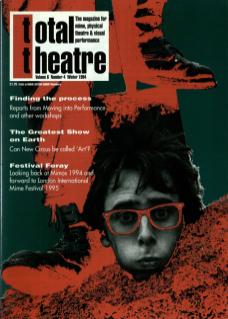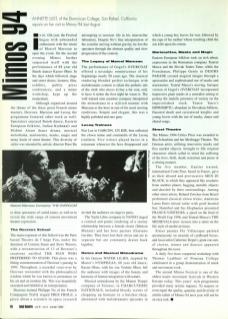In its 12th year, the Festival began with unbounded enthusiasm with the return of Marcel Marceau to open the event. On the second evening Mimos further surpassed itself with the performance of 88 year old Butoh dancer Kazuo Ohno. In the days which followed, stage and street shows, lectures, film, exhibits, public press conferences, and a mime workshop kept up the momentum.
Although organised around the theme of the three great French mime masters, Decroux, Marceau and Lecoq, the programme featured other work as well. Spectators enjoyed Butoh dance, Eastern European folklore, Indian Kathakali and Mohini Attam dance drama, musical melodrama, marionettes, masks, magic and many kinds of street theatre. This diversity of styles was intended by artistic director Peter Bu to draw spectators of varied tastes, as well as to reveal the wide range of current movement theatre expression.
The Decroux School
The main exponent of this School was the Paris based Théâtre de l'Ange Fou, under the direction of Corinne Soum and Steve Wasson, with a reconstruction of thirteen of Decroux's creations entitled The Man Who Preferred to Stand. This piece was a fitting commemoration of Decroux's passing in 1993. Throughout, a recorded voice-over by Decroux resounded with the philosophical wisdom which he was known to pronounce on his art and on modern life. This was beautifully executed and faithful in its interpretation.
Decroux-trained Philippe No of the French Compagnie Trafik staged Fres Frole, a piece about a scientist in space research attempting to recreate life in his interstellar laboratory. Despite No's fine interpretation of the scientist moving without gravity, he lost the spectator through the abstract quality and slow progression of the content.
The Legacy of Marcel Marceau
The performance of Gogol's Overcoat offered a nostalgic reminiscence of his beginnings nearly 50 years ago. The classical rendering blended perfect technique with melodramatic content to relate the pathetic tale of the clerk who slaves to buy a fur coat, only to have it stolen the first night he wears it. The well trained nine-member company interpreted the mimodrama in a stylised manner with Marceau as the hero in one of his most moving renditions. Simple and elegant, this was a highly polished and rare gem.
Lecoq trainees Fiat Lux in Garcon, Un Kir best reflected the clown, mime and commedia of the Lecoq tradition. Five writers played havoc in a restaurant whenever the boss disappeared and invited the audience on stage to party.
The Vache Libre company in Tango staged a comical and poetic rendering of a stormy relationship between a female clown (Meriem Menant) and her boss partner (Gaetano Lucido). They have lost their circus and are to separate but are constantly drawn back together.
Dance and Musical Mimodrama
In his famous Water Lilies, inspired by Monet's Nympheas, 88 year old dancer Kazuo Ohno, with his son Yoshito Ohno, left the audience with images of the beauty and harmony of human integration with nature.
Musical mimodrama by the Manon Troppo company of Toulouse, in Charcuterie Nationale, included bloody scenes of chopping up humans in a butcher-shop, alternated with melodramatic episodes in which a young boy leaves for war, followed by the rape of his mother whose resulting child the son kills upon his return.
Marionettes, Masks and Magic Eastern European folklore took on rich ethnic expression in the Romanian company Teatrul Masca and the Slovak Teatro Tatro, while the Frenchman, Philippe Genty in Desirs Parade created magical images through a spectacular and sophisticated use of masks and marionettes. Teatrul Masca's moving, baroque version of Gogol's Overcoat incorporated impressive giant masks in a surrealist setting to portray the malefic pressures of society on the impoverished clerk. Teatre Tatro's Impromptu, abundant in Slovakian folklore, flaunted death and caricatured knights and young lovers with the use of masks, dance and choral songs.
Street Theatre
The Mimos 1994 Critics Prize was awarded to Ilka Schonbien and her Meshugge Theatre. The German artist, utilizing innovative masks and flea market objects, brought to life original characters which called to mind the suffering of the Jews, birth, death, terrorism and peace in a stirring manner.
The five member, Gaulier-trained, international Contr Pour, based in France, gave us their absurd and provocative Men in Black, in which they appeared like creatures from another planet, hugging metallic objects and dazzled by their surroundings. Among other street artists, Roland Zwicker from Brazil performed classical clown tricks, American Laura Herts mixed satire with good hearted fun; Hannibal and Ses Elephantes presented France-Visiteurs, a spoof on the final of the World Cup 1998, and Teatrul Masca's The Medievals drew viewers into a satire on the lifestyle of medieval times.
Street painter Flo Villaceque painted spontaneously on mounds of cardboard boxes, and local artist Catherine Depin's giant cut-outs of clowns, mimes and dancers appeared throughout the town.
A daily five-hour corporeal workshop with Thomas Leabhart of Pomona College culminated in a group demonstration of mask and movement work.
The annual Mimos Festival is one of the oldest major movement festivals in Western Europe today. This year’s rich programme provided many artistic impacts. To surpass or even equal the quality, quantity and diversity of artistic talent of Mimos 94 next year will not be an easy task.

